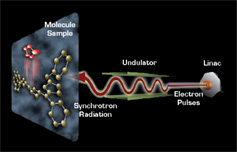

Monday - April 24, 2006
SLAC Today is
available online at:
http://today.slac.stanford.edu
In this issue:
SLAC First in Hard X-Ray Lasers
Dorfan Today: Planning the Future of Particle Physics
Public Lecture: Joanne Hewett
 |
 |
|
Monday - April 24, 2006 |

The LCLS will use free electron laser (FEL) technology. SLAC First in Hard X-Ray LasersResearch and equipment at SLAC enable it to host the world's first hard x-ray laser. In the Linac Coherent Light Source (LCLS), state-of-the-art technology will harness photons with the shortest wavelength ever corralled into coherence. Soft x-ray lasers harness photons with wavelengths greater than one nanometer. SLAC will use hard x-rays, whose one nanometer and smaller wavelengths possess higher energies. In a traditional laser, electrons release photons as they drop to a lower energy orbital around their atoms. Those found in grocery store scanners and laser pointers typically use light within the visible spectrum and require electrons to bounce between mirrors millions of times until they radiate light in phase. But by doing so, the efficiency of the process dwindles. X-ray lasers escape these constraints by using free electron laser (FEL) technology that uses an electron beam rather then electrons bound to atomic or molecular states. Read more... |
||||||||||||||||||||||||||
|
|
||||||||||||||||||||||||||

Planning the Future |
Public Lecture:
|
Events (see all | submit)
Access (see all)
Announcements
|
||||||||||||||||||||||||
| | ||||||||||||||||||||||||||
What's Cookin' at the Linear Cafe (see weekly menu)
|
||||||||||||||||||||||||||
|
|
||||||||||||||||||||||||||
 <%
Response.AddHeader "Last-modified", getArticleDate()
'Response.AddHeader "Last-modified","Mon, 01 Sep 1997 01:03:33 GMT"
'Monday, December 06, 2010
%>
<%
Response.AddHeader "Last-modified", getArticleDate()
'Response.AddHeader "Last-modified","Mon, 01 Sep 1997 01:03:33 GMT"
'Monday, December 06, 2010
%>View online at http://today.slac.stanford.edu/. |
||||||||||||||||||||||||||